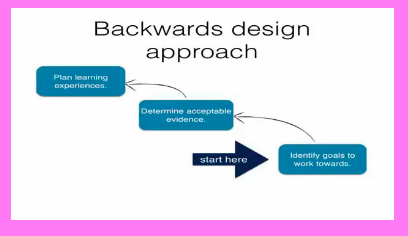


.Why apply Backwards Design to curriculum design?
- Curriculum needs to meet constraints such as:
- state / national standards,
- class size,
- 504 and Special Ed. accommodations,
- student interests, etc.
- Need to deeply understand WHAT to teach, before selecting HOW to teach
- Shift focus from Teaching first to Learning first
- Need to deeply understand WHAT students will learn and WHY it’s important to learn it
Common Pitfalls of Traditional Design:
- Hands on without minds on (no rigor)
- Coverage instead of un-coverage:
- Textbook used as a framework for ideas
- Lack of intellectual framework for ideas means that students never learn big ideas and relevance and transfer of these ideas
3 Stages of Backwards Design:
- Identify Desired End Results:
- Study standards and learning goals
- Identify learning goals and desired enduring understandings
- Prioritize learning goals
- Determine Acceptable Evidence:
- Determine what evidence we will accept to show that students have achieved mastery of goal
- Plan Learning Experiences and Instruction:
- What foundational skills will students need to reach goals?
- Purposefully design and analyze learning tasks: how will formative assessments be used to develop student learning? what tasks will help students develop a deep understanding of learning goals?
- Avoid common errors (see pitfalls above)

Developing a clear picture of the end results of a project in terms of student learning is a key step in designing effective projects. Projects present many opportunities to teach transfer and relevance of concepts, but these oppotunities rarely come about by accident. These understandings can only emerge if projects are intentionally designed to meet constraints that directly relate to student learning. Understanding what standards say, how the content in them is connected to a larger framework, and using that framework to make prioritizing decisions can help one design projects that focus resources on the most important ideas and skills students need to learn.

Preliminary Steps
- Learn more about Understanding by Design’s approach – see related articles below or read the book
- Study the standards: analyze nouns, verbs and contexts in standards; analyze standardized and performance assessments related to the standards
- What will students need to be able to do and understand to demonstrate mastery of standards?
- Why are these skills and understandings important?
- How do these skills and understandings relate to the big ideas and themes in the discipline?
- What foundational skills are needed to approach content mastery?
- Connections to products and 21st century skills?
- What products naturally fit with learning goals embedded in the standards?
- What 21st century skills will students need to develop to enhance their learning and application of learning to developing products?
- After a clear vision of learning goals is found, decide what evidence will be investigated to check if students are developing mastery.
- After assessments are planned, select learning tasks that are aligned to learning goals, that help students develop targeted 21st skills, create products, and demonstrate mastery of goals in assessments
- Document the key analyses in the bullets above in a project planning form
Early Implementation Steps
- Implement learning tasks and assessments while avoiding pitfalls of hands on/minds off and coverage as opposed to un-coverage
- Use assessments to evaluate whether or not learning tasks are effective and to make adjustments as needed
Advanced Implementation Steps
- Integrate design principles from Understanding by Design with design principles from Human Centered Design
- Study assessment results over time and design assessments that assess whether or not students are learning big ideas and how these are connected in a conceptual framework
.
